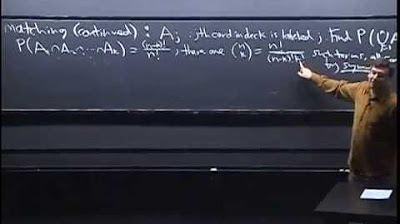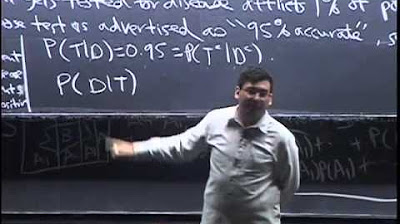Conditional Expectation-I
TLDRThis lecture introduces the concept of conditional expectation, a key topic in probability not typically covered in standard courses. The professor uses a coin-tossing example to illustrate how additional information can change expectations, then moves to a more rigorous definition involving finite sample spaces and sigma-algebras. The lecture also discusses the countable partition and its role in defining conditional expectation, emphasizing its importance in probability theory and its application in finance.
Takeaways
- 📚 The lecture introduces the concept of conditional expectation, a topic not commonly covered in standard probability courses for engineers or economists.
- 🎯 Conditional expectation is pivotal in probability theory and is explored through the lens of finance in the book 'Probability for Finance' by Sean Dineen.
- 🎲 The script uses a simple example of tossing a fair coin to illustrate the concept of conditional expectation, particularly how knowing the outcome of the first toss affects the expectation of the number of heads in three tosses.
- 🧩 The expectation of a binomial random variable, representing the number of heads in coin tosses, is calculated as n times p, where n is the number of trials and p is the probability of success (in this case, 3 * 0.5 = 1.5).
- 🔑 Conditional expectation changes based on new information; for example, knowing the first toss is a head increases the expected number of heads in the remaining tosses.
- 📉 The script contrasts the conditional expectation when the first toss is a head versus a tail, showing how expectations adjust with additional information.
- 📈 The mathematical definition of conditional expectation is presented for a finite sample space, where the probability of each outcome is strictly greater than zero.
- 🌐 The concept extends to the idea of conditioning on a sigma-algebra, which is a set of events that represents the information available to make probabilistic statements.
- 🔍 The script discusses the countable partition of the sample space and how it generates a sigma-algebra, which is essential for defining conditional expectation in more complex scenarios.
- 📝 The conditional expectation is characterized as a random variable that remains constant over events within the same partition and is measurable with respect to the sigma-algebra.
- 🔑 The lecturer highlights the importance of proving that the conditional expectation, given a sigma-algebra generated by a countable partition, is also integrable if the original random variable is integrable.
Q & A
What is the main topic of the lecture?
-The main topic of the lecture is conditional expectation, a concept in probability theory.
Why is conditional expectation considered important in this lecture?
-Conditional expectation is considered important because it is a fundamental concept not usually covered in standard courses for engineers or economists, and it has unique applications in fields like finance.
What book is recommended for further reading on conditional expectation?
-The book recommended for further reading is 'Probability for Finance' by Sean Dineen, published by the American Mathematical Society in 2005.
What is the example used in the lecture to explain conditional expectation?
-The example used is the scenario of tossing a fair coin three times and calculating the expected number of heads, given the condition that the first toss resulted in a head.
What is the expected number of heads in three tosses of a fair coin without any conditions?
-The expected number of heads in three tosses of a fair coin is 1.5, calculated as 3 (tosses) multiplied by the probability of getting a head (0.5).
How does the knowledge of the first toss being a head affect the conditional expectation of the number of heads in the remaining tosses?
-Knowing the first toss is a head changes the conditional expectation to 2 heads in the remaining two tosses, as the first toss is already a head.
Outlines
🎓 Introduction to Conditional Expectation
The first paragraph introduces the concept of conditional expectation, an important topic not typically covered in standard probability courses for engineers or economists. The lecturer references a book by Sean Dineen titled 'Probability for Finance' as a key resource. A simple example is used to illustrate the concept, involving the expected number of heads in three tosses of a fair coin, and then adjusting this expectation given the condition that the first toss resulted in heads. The explanation shows how additional information can change the expectation, setting the stage for a deeper exploration of conditional expectation in probability theory.
🔍 Conditional Expectation with a Known Outcome
This paragraph delves deeper into the example of tossing a coin, using it to explain how the conditional expectation changes with known outcomes. The lecturer demonstrates the calculation of expected heads given that the first toss is a head, and contrasts this with the scenario where the first toss is a tail. The explanation emphasizes how the expectation of future events can be influenced by current information, and introduces the concept of a finite sample space and the power set of events, laying the groundwork for a more formal definition of conditional expectation.
📚 Formal Definition of Conditional Expectation
The third paragraph presents a formal definition of conditional expectation in the context of a finite sample space and a sigma-algebra. The lecturer explains the conditional expectation of a random variable X given an event A, using the notation F for the sigma-algebra, which is common in finance literature. The definition involves summing the product of the random variable and the conditional probability of each outcome, given that the event A has occurred. This formalism allows for a more rigorous understanding of how to calculate conditional expectations in various scenarios.
📉 Conditional Expectation as a Random Variable
In this paragraph, the lecturer discusses the idea of viewing conditional expectation as a random variable itself. This is demonstrated by considering the sigma-algebra generated by an event A and defining a function that is constant over the events within this sigma-algebra. The paragraph explains how this function can be seen as a random variable, which is a key concept in understanding conditional expectation in a broader context. The lecturer also touches on the idea of countable partitions and how they relate to sigma-algebras, which is important for extending the concept to non-finite sample spaces.
🔢 Countable Partitions and Sigma-algebras
The fifth paragraph explores the concept of countable partitions of the sample space and their associated sigma-algebras. The lecturer defines a countable partition as a sequence of disjoint sets whose union is the entire sample space. The paragraph discusses how to generate a sigma-algebra from such a partition and how this can be used to define conditional expectation in a more general setting. The explanation includes the importance of integrability and how it relates to the finite expectation of both the original random variable and its conditional expectation.
📘 General Definition of Conditional Expectation
The sixth paragraph builds on the previous discussion to present a general definition of conditional expectation for any sub-sigma-algebra of F. The lecturer introduces the concept of a unique measurable random variable that characterizes conditional expectation over a sigma-algebra generated by a countable partition. The paragraph also mentions the importance of this property in extending the definition of conditional expectation to more complex scenarios, hinting at its connection to the Radon-Nikodym theorem.
📝 Proof of Conditional Expectation Properties
In the final paragraph, the lecturer provides a proof for the properties of conditional expectation, specifically focusing on the case where the sigma-algebra is generated by a countable partition. The proof demonstrates how the integral of the original random variable X over any set in the sigma-algebra is equal to the integral of the conditional expectation over the same set. The explanation includes a step-by-step breakdown of the proof, highlighting the uniqueness and existence of the conditional expectation as a measurable random variable, and concludes the discussion for the day.
Mindmap
Keywords
💡Conditional Expectation
💡Binomial Random Variable
💡Probability Space
💡Sigma-Algebra
💡Countable Partition
💡Integrable Random Variable
💡Conditional Probability
💡Measurable Function
💡Radon-Nikodym Theorem
💡Uniqueness
Highlights
Introduction to the concept of conditional expectation, a key topic in probability theory.
Conditional expectation is not commonly covered in standard courses for engineers or economists.
Reference to the book 'Probability for Finance' by Sean Dineen as a valuable resource.
Explanation of conditional expectation using a simple example of tossing a fair coin.
Calculation of the expectation of a binomial random variable representing coin tosses.
How additional information, such as the outcome of the first toss, changes the conditional expectation.
The impact of knowing the first toss result on the expected number of heads in subsequent tosses.
The mathematical formulation of conditional expectation in the context of a finite sample space.
Definition of conditional expectation given an event with a strictly positive probability.
The role of the sigma-algebra in defining conditional expectation and its properties.
Transcripts
5.0 / 5 (0 votes)
Thanks for rating:





